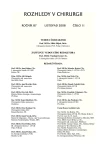The Use of Biodegradable Materials in the Management of Bone Cysts in Children
Authors:
L. Plánka; Š. Ondruš; J. Škvařil; D. Starý; P. Gál
Authors‘ workplace:
Klinika dětské chirurgie, ortopedie a traumatologie FN Brno, přednosta: prof. MUDr. Petr Gál, Ph. D.
Published in:
Rozhl. Chir., 2008, roč. 87, č. 11, s. 585-589.
Category:
Monothematic special - Original
Overview
Aim:
The commonest benign lytic bone disorders, which compromise the bone robustness include juvenile bone cysts. Provided the cysts do not undergo spontaneous healing, which is commonly facilitated by pathological fracturing or introduction of osteosynthetic material into the cyst, the cystic cavity must be filled in. Numbers of potential defect management procedures, including use of corticoids, autografts, allografts or recently introduced methods of application of synthetic anorganic biomaterials, have been used. The aim of this study is to assess a possibility of the biomaterials use in the management of benign cysts in children.
Material and Methodology:
The study included 20 juvenile bone cysts patients aged 10–17, treated with tricalcium phosphate during 2004–2007 in the KDCHOT. The authors assessed rates of the procedures, therefore a number of required hospitalizations and total anesthesias, intraoperative complications, postoperative complications, durations of hospitalization and treatment outcomes, based on Neer criteria, including the cyst’s time - to - heal interval. In addition, evaluation of the results was related to the cyst’s location.
Results:
The treatment results, assessed according to the Neer criteria, show that 90% of the cysts healed and did not require further surgical intervention. Poor outcome was recorded in 2 subjects, who required further surgery due to skeletal instability. Intraoperative and perioperative complications were insignificant, the average duration of hospitalization was 4 days and the average time - to - heal period following primary or secondary percutanneous cyst filling was 15 months (ranging from13 to 20 months).
Conclusion:
The studied method of the tricalcium phosphate application resulted in reduced rates of surgical procedures required for the defect healing. Furthermore, it is not associated with serious perioperative or intraoperative complications and the hospitalization duration may be very short.
Key words:
tricalcium phosphate – pathological fracture – juvenile bone cyst – childhood
Sources
1. Ahn, J. I., Park, J. S. Pathological fractures secondary to unicameral bone cysts. Int. Orthop., 1994; 18 : 20–22.
2. Arazi, M., Senaran, H., Memik, R., Kapicioglu, S. Minimally invasive treatment of simple bone cyst with percutaneous autogenous bone marrow injection. Orthopaedics, 2005; 28 : 108–202.
3. Arrington, E. D., et al. Complications of iliac crest bone graft harvesting. Clin. Orthop., 1996; 329 : 300–309.
4. Burger, E. L., Patel, V. Calcium phosphates as bone graft extenders. Orthopedics, 2007; 30; 939–943.
5. Campanacci, M., Capanna, R., Picci, P. Unicameral and aneuryzmal bone cysts. Clin. Orthop., 1986; 204 : 25–36.
6. Chang, C. H., Stanton, R. P., Glutting, J. Unicameral bone cysts treated by injection of bone marrow or methylprednisolone. J. Bone Joint Surg. /Br/, 2002; 84-B: 407–412.
7. Docquier, P. L., Delloye, C. Treatment of simple bone cysts with aspiration and a single bone marrow injection. J. Pediatr. Orthop., 2003; 23 : 766–773.
8. Hashemi-Nejad, A., Cole, W. G. Incomplete healing of simple bone cysts after steroid injections. J. Bone Joint Surg. /Br/, 1977; 79-B: 727–730.
9. Cho, H. S., Oh, J. H., Kim, H. S., Kang, H. G., Lee, S. H. Unicameral bone cysts: s comparison of injection of steroid and rafting with autologous bone marrow. J. Bone Joint Surgery /Br/, 2007; 89, 222–226.
10. Tsuchyia, H., Abdel-Wanis, M. E., Uehara, K., Tomita, K., et al. Cannulation of simple bone cyst. Joural of bone and joint Surgery (Br), 2002; 84 : 245–248.
Labels
Surgery Orthopaedics Trauma surgeryArticle was published in
Perspectives in Surgery

2008 Issue 11
- Metamizole vs. Tramadol in Postoperative Analgesia
- Metamizole at a Glance and in Practice – Effective Non-Opioid Analgesic for All Ages
- Metamizole in perioperative treatment in children under 14 years – results of a questionnaire survey from practice
Most read in this issue
- The Use of Biodegradable Materials in the Management of Bone Cysts in Children
- Biliary Ileus – Potential Complication of Cholecystolithiasis
- Operation Treatment of the Humeral Shaft Fractures
- Minimally Invasive Surgery in the Czech Republic
